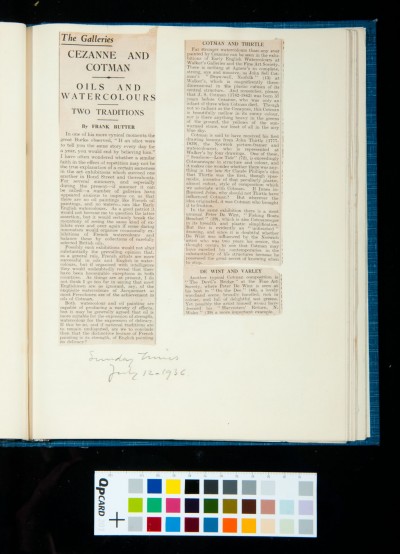Cotmania. Vol. XI. 1935-6
Archive: SDK Sydney Decimus Kitson Archive
Reference Number: SDK/1/2/1/11
Page: 35 recto
-
Description
Cézanne and Cotman, and exhibitions at Walker's Galleries and the Fine Art Society: article from the Sunday Times, 21 July 1936
Date:
-
Transcription
THE GALLERIES
CEZANNE AND COTMAN
OILS AND WATERCOLOURS
TWO TRADITIONSBy Frank Rutter
In one of his more cynical moments the great Burke observed, "If an idiot were to tell you the same story every day for a year, you would end up believing him." I have often wondered whether a similar faith in the effect of repetition may not be the true explanation of a certain sameness in the art exhibitions which succeed each other in Bond Street and thereabouts. For several summers, and especially the present - if summer it can be called - a number of galleries have appeared anxious to impress on us that there are no oil paintings like French oil paintings, and no water colours like early English water colours. As a good patriot it would not become me to question the latter assertion, but it would certainly break the monotony of seeing the same kind of exhibits over and over again if some daring innovators would organise occasionally exhibitions of French water colours and balance these by collections of carefully selected British oils.
Possibly such exhibitions would not alter substantially the prevailing opinion that, as a general rule, French artists are more successful in oil and English in water colours, but if organised with intelligence they would undoubtedly reveal that there have been honourable exceptions in both countries. As things are at present, I do not think I go too far in saying that most Englishmen are as ignorant, say, of the exquisite watercolours of Jacquemart as most Frenchmen are of the achievement in oils of Cotman.
Both watercolour and oil paintings are capable of producing a variety of effects, but it may be generally agreed that oil is more suitable for the expression of strength, watercolour for the expression of delicacy. If this be so, and if national traditions are to remain undisputed, are we to conclude then that the distinctive feature of French painting is its strength, of English painting its delicacy?COTMAN AND THIRTLE
Far stronger watercolours than any ever painted by Cezanne can be seen in the exhibitions of Early English Watercolours at Walker's Galleries and the Fine Art Society. There is nothing at Agnew's so complete, strong, aye and massive, as John Sell Cotman's "Draw-Well, Norfolk" (13) at Walker's, which is magnificently three-dimensional in the plastic cubism of its central structure. And remember, please, that J. S. Cotman (1782-1842) was born 57 years before Cezanne, who was only an infant when Cotman died. Though not so radiant as the Cezannes, this Cotman is beautifully mellow in its sunny colour, nor is there anything heavy in the greens of the ground, the yellows of the sun-warmed stone, nor least of all in the airy blue sky.
Cotman is said to have received his first drawing lessons from John Thirtle (1777-1839), the Norwich picture-framer and watercolourist, who is represented at Walker's by four drawings. One of these, "Seashore- Low Tide" (72), is exceedingly Cotmanesque in structure and colour, and it makes on wonder whether there was anything that in the late Sir Claude Phillip's idea that Thirtle was the first, though spasmodic, inventor of that peculiarly plastic, almost cubist, style of composition which we associate with Cotman. If Innes influenced John, why should not Thirtle influence Cotman? But wherever the idea originated, it was Cotman who brought it to fruition.
In the same exhibition there is a most unusual Peter De Wint, "Fishing Boats Beached" (29), which is also Cotmanesque in its breadth and plastic simplification. But this is evidently an "unfinished" drawing, and since it is doubtful whether De Wint was influenced by the Norwich artist who was two years his senior, the thought occurs to one that Cotman may have excelled his contemporaries in the substantiality of his structures because he possessed the great secret of knowing when to stop.DE WINT AND VARLEY
Another typical Cotman composition is "The Devil's Bridge" at the Fine Art Society, where Peter De Wint is seen at his best in "On the Dee" (46), a lovely woodland scene, broadly handled, rich in colour, and fill of delightful wet greens. Yet possibly the artist himself would have deemed his "Harvesters' Return, N. Wales" (39) a more important example.Sunday Times
July 12, 1936
